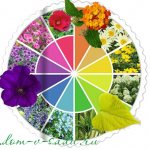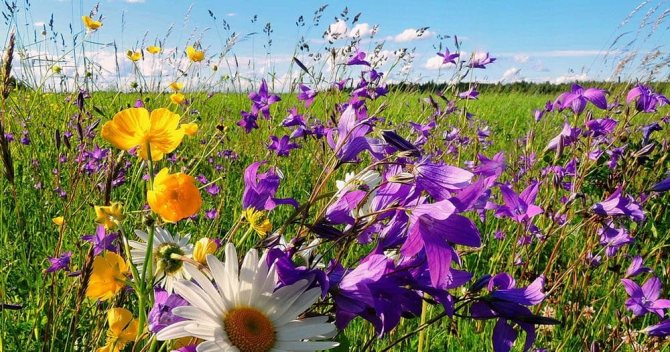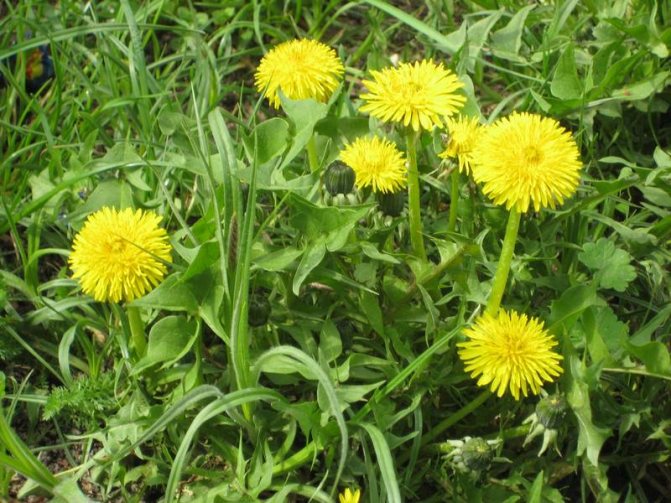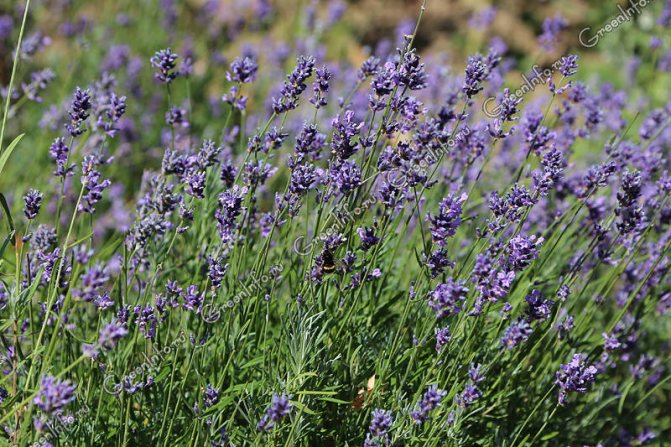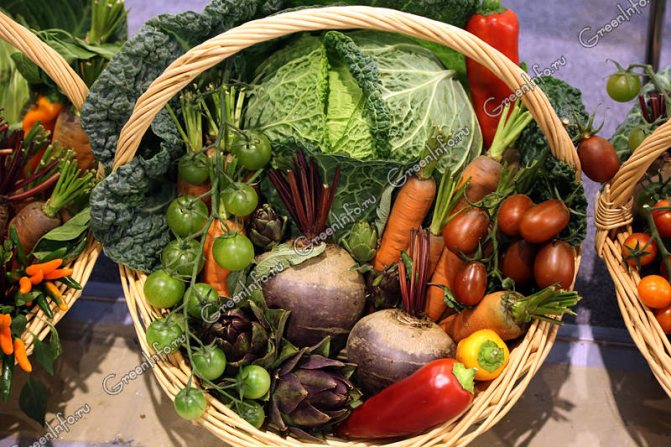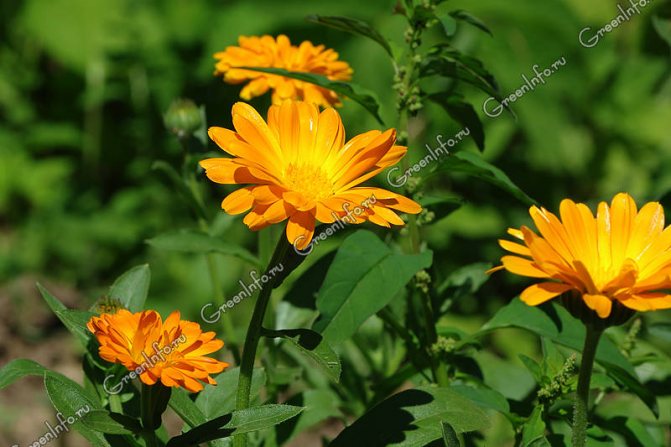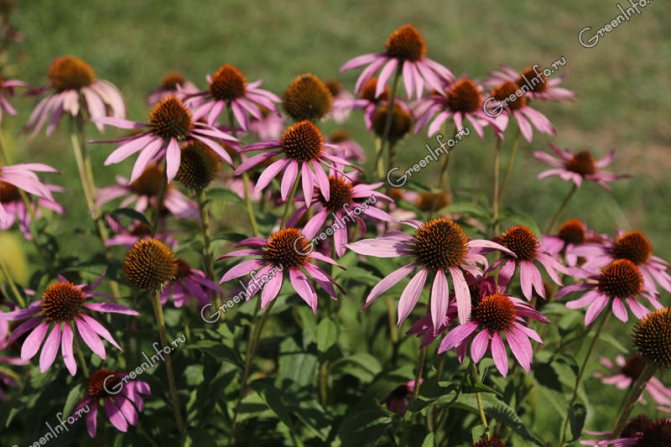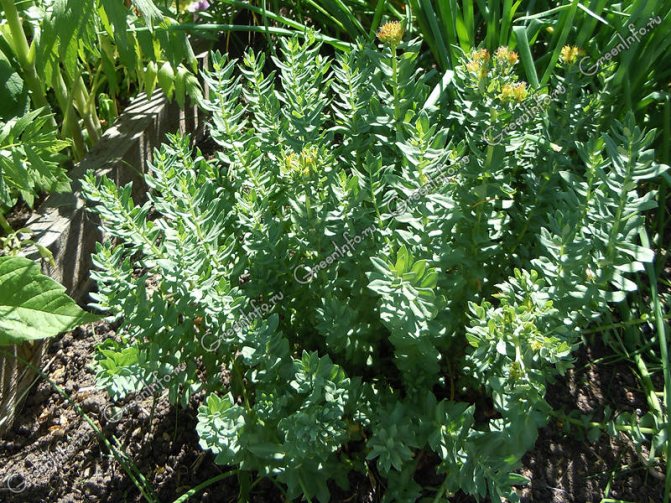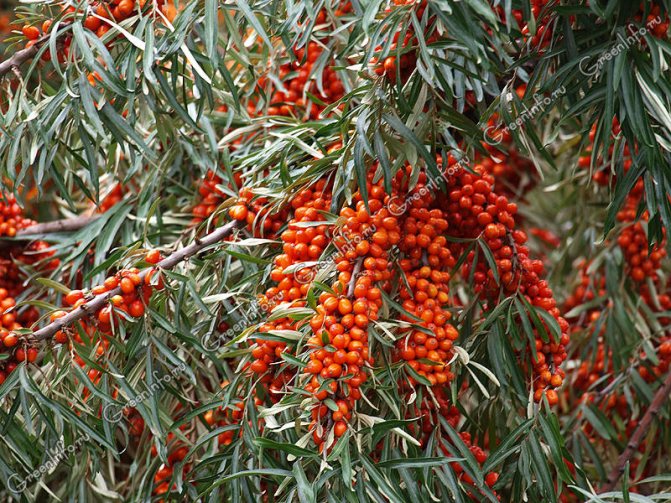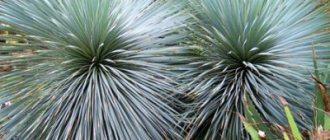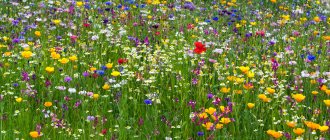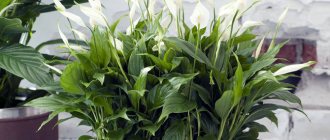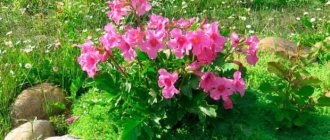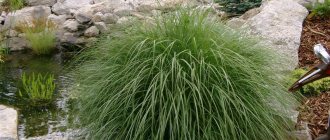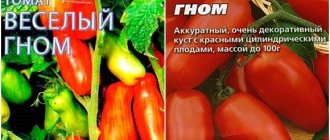Do-it-yourself flower bed in the country for beginners: advice from professionals
In order for the flower garden to turn out successfully the first time, you will need to fulfill many conditions:
- The soil for the flower bed must be fertile. Its composition must be taken into account when choosing plants.
- All of them should be comfortable on the available ground.
- The place for the flower bed must be chosen so that all its sections are well lit.
- Thoroughly think over the shape and scheme of the future flower garden.
- The main shade of the flower bed also needs to be responsibly. Variegated or too pale - she will not fulfill her role. Let there be a few bright spots against the background of the rest - pastel.
- Plants are supposed to be placed in a flower bed in groups.
- For novice gardeners, perennials are preferred. And not all, but those that do not require careful maintenance.
- The number of plant species should not be large. Especially if perennials are planted. Over time, they will grow and the flower bed will look sloppy.
- For the same purpose, do not plant them too thickly. Let there remain free space, which in the first years can be filled with annuals.
- Tall plants - from 80 to 150 cm - should be planted in the background of a flower bed or in its center. Low - up to 30 cm in height - in the foreground or along the contour of the flower garden. And medium-sized ones between them.
- Choose plants so that among them there are those that bloom in spring, others in summer, and always in autumn.
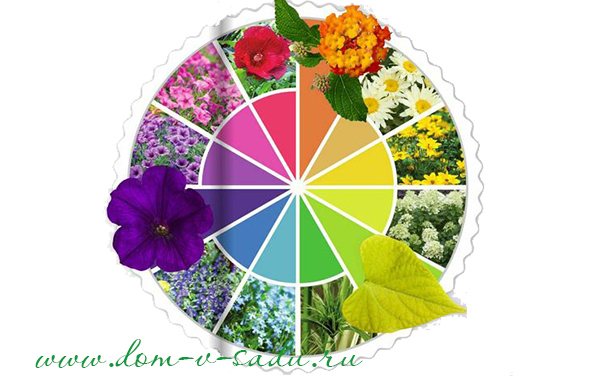
Scheme of a simple and beautiful perennial flower bed for beginners
Flower gardens are divided into two large groups: regular and irregular. In the first, the pattern of plants is permanent and has strict geometric lines. Such a flower bed is within the power of an experienced gardener. It is recommended for beginners to create irregular flower beds. They do not have a clear border between plantings. They are placed in random groups, and also have different flowering times. It is easier to cope with such a flower bed. The main thing is to choose plants so that at least one of them blooms when the rest have already faded.
As a recommendation from professionals, the words sound about how to draw a future flower bed on paper in advance. You can even paint it in the desired colors and put down the flowering time. So what will be the result will be clearly seen.


The names of the flowers planted in this flowerbed near a private house: Tagetis. Sedum. Chamomile. Rod-shaped millet. Budleya. Sage.
As for the shape of the flower garden, it can be any. And there may be no clear-cut scheme at all. It can be limited to a tub or old wheelbarrow, walk along a path, or be an island in the middle of a garden.
Round flower bed in the country.
The simplest round flower bed in terms of decorating a summer cottage area. The main difficulty here lies in the selection of its size. A small one in a large space will be lost, and a voluminous one in a very limited one will not allow you to appreciate it at its true worth. Round flower beds on the site look good around trees. It is necessary to select flowers for such a flower bed that are shade-tolerant. In the most shady corners of the garden, decorative-leaved hosts and astilbes feel good.
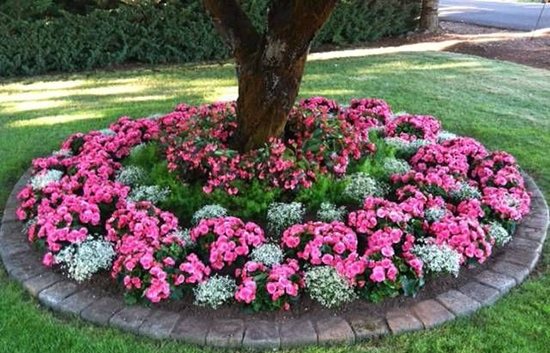

The planting scheme in a round flower bed is very simple! You can simply break it into concentric circles and place plants of the same height in this way. For those who feel that his strength and abilities are enough for something more, you can draw a large chamomile or a sun with flowers.
What flowers grow in flower beds near the house?
All plants can be divided into three large groups according to the complexity of caring for them. The first contains the most unpretentious of them. They are not demanding on growing conditions. Since they are not afraid of frost, they are resistant to the appearance of diseases, they are not susceptible to pest attacks. They can be left in one place for several years, because they are not demanding on the composition of the soil.
This group includes plants: geranium, daffodil, aconite, goldenrod, gentian, doronicum and musk mallow.
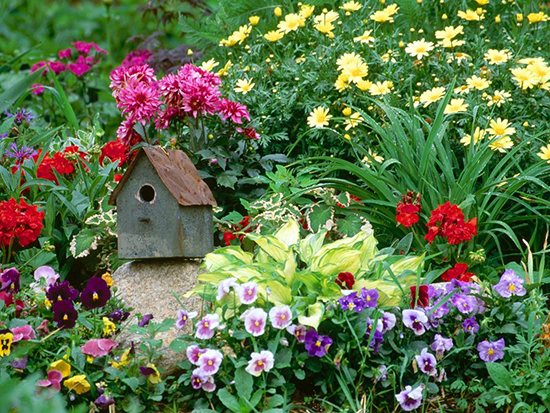

The center of this flower bed is a stone with a bird's house, planted around: hosta, large pansies, chrysanthemums, daylilies
The second group consists of moderately labor intensive plants. They need special conditions for growth or they need to be replanted every few years. However, they do not require daily maintenance.
This group includes: cornflower, carnation, iris, tulips, bell and phlox.
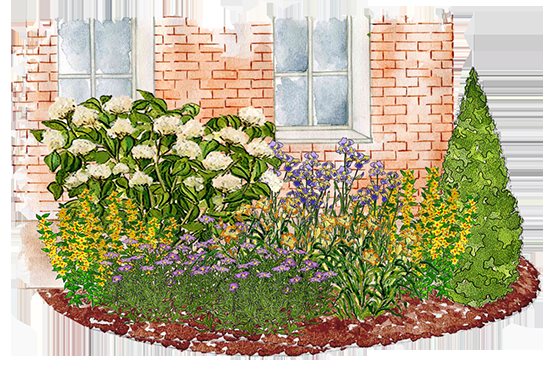

The names of plants and flowers in the flowerbed: thuja western, hybrid iris, aster shrub, daylily, loosestrife, hydrangea
The latter is laborious. These plants need daily and painstaking care. Such flowers are not recommended for use in flower beds created by novice summer residents.
By the way, many of these plants are suitable for continuous flowering beds. So for months they will bloom:
- in March - crocuses, a little later pansies;
- in April - early daffodils with tulips;
- in May - lilies of the valley and forget-me-nots, tulips and daffodils;
- in June - chamomiles, irises, carnations and bells;
- in July - phlox;
- in August - goldenrod;
- in September - late chrysanthemums and pansies.


Spring flowerbed with crocuses
An example of how a perennial flower bed for beginners can be made, which has a round shape. And the pattern is a chamomile.
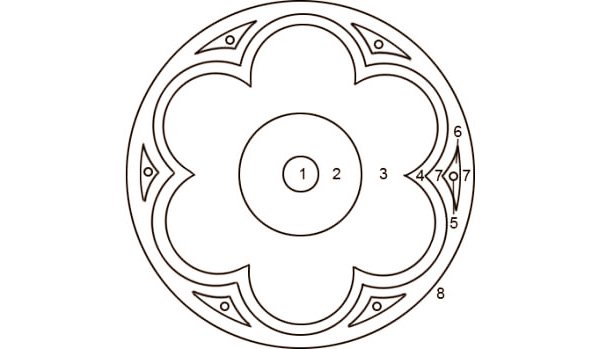

Levkoi are planted in the center of the flower garden. Alpine forget-me-not is planted around it. Then the fescue is located, which gives the petal pattern. A narrow strip of pansies is planted along their contour. In the intervals between the petals of the pattern, you can plant primrose or zinnia. And fill the space between with an alternative.
Flower names in the flowerbed:
- Levkoy (matiolla),
- Alpine forget-me-not,
- Red fescue,
- Pansies (there is a variety of large pansies "V. t. Maxima" - it blooms all season),
- Primrose - refers to unpretentious flowers, which are one of the first to bloom in the spring.
- Zinnia is a tall flower that pleases the eye in the second half of summer and early autumn, unpretentious, easy to care for, if you want early flowering, it is recommended to grow through seedlings.
- Alternantera "Aurea nana" is an ornamental-leaved plant that can be grown as a houseplant.
- Achiranthes Vershaffelt is prized for its decorative fleshy leaves, which are most often used by landscape designers to decorate patterned flower beds.


Each apartment building has a small piece of land that can be used to create a flower bed. Blooming plants create a special atmosphere of comfort. In order for the flower garden to have an attractive appearance, plants are selected there, taking into account their flowering period, climatic conditions and soil composition. Plants look attractive, harmoniously grouped according to their size, shape and color. Flowering species can be combined with decorative leafy specimens, highlighting the beauty of each plant. When organizing flower beds at the entrance of an apartment building, it is important not to overload the composition with unnecessary abundance.
Using
Tomato fruits are eaten fresh, boiled, fried, canned, they are used to prepare tomato paste, all kinds of sauces, juices, lecho.
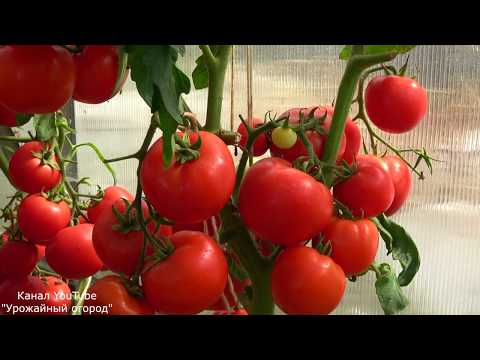

The herbaceous plant tomato is one of the most common in the backyards of the middle lane. It is grown both outdoors and in greenhouses.Depending on the variety, the bushes can be of different heights - dwarf 30-centimeter hybrids and tall, spreading plants that grow up to one and a half meters are widely cultivated.
According to the doctor's recommended consumption rate, tomato is in second place after cabbage - 30 kg per person per year (this is 2.5-3 times more than cucumber). The share of the tomato should account for 25% of all vegetables in the human diet. This is due to the peculiarities of the national cuisine, nutritional and healing properties.
The homeland of the cultivated tomato plant is the mountainous regions of Peru, Mexico. There it was known as a food plant in the 5th century. BC e., and came to Europe only in the 16th century. They looked closely at it for a long time, used it as an ornamental plant, romantically called it "the apple of love" and "the golden apple", and Gianni Rodari gave one of the heroes of his fairy tale the name Signor Tomato.
You can familiarize yourself with the description of the tomato plant and its biological characteristics on this page.
What are the requirements for flowers planted near the entrance of an apartment building
Before creating a flower garden, it is recommended to plan its territory and determine the places for planting plants. Experienced flower growers advise placing flowers next to each other, the flowering time of which does not coincide. You can create a flower garden so that the color scheme of flowering plants with a soft overflow transitions from one shade to another.
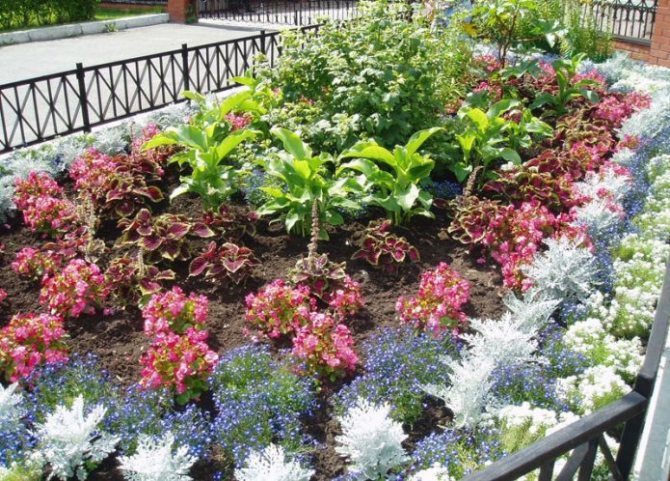

Flower garden in the local area
When choosing flowers for a flower bed near the entrance, be guided by the following requirements:
- plants should be viable, resistant to drought and partial shade, and easy to care for;
- perennial plants are the best option for a flower garden, since they do not require annual planting in the ground;
- fragile specimens are not suitable for a house garden, since with gusts of wind and heavy rain they will lose their aesthetic appearance;
- choose inexpensive but catchy types of flowers;
- Plentiful and long-flowering plant species are considered the best options.
When placing flowers in a flower bed, you can plant next to perennial plants and annuals, which make it possible to annually update the flower arrangement in a new way.
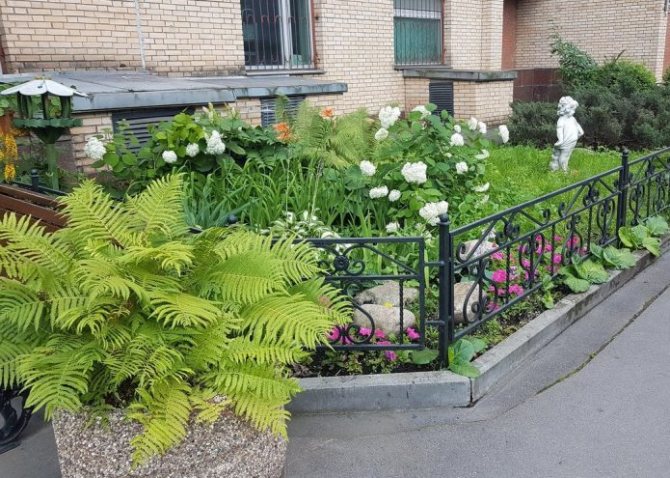

Garden garden with annuals and perennials
Try to pick up flowers that are friendly to each other, similar in terms of watering, requirements for soil composition, and sunlight. You should not use perennials that grow rapidly, fill all the free space and drown out the growth of other plants.
Composition of tomato fruits
Ripe tomato fruits are rich in sugars and vitamin C, contain proteins, starch, organic acids, fiber, pectin, calcium, sodium, magnesium, iron, chlorine, phosphorus, sulfur, silicon, iodine, as well as carotene, lycopene (it determines the red color fruits), B vitamins, niacin and folic acid, vitamin K.
Fresh tomatoes and tomato juice are useful for cardiovascular diseases, gastritis with low acidity, general loss of strength, weakening of memory, anemia. Tomato is also used as a laxative. Gruel of red tomatoes is applied to the swollen veins (bandaged at night every day or every other day for a month).
What flowers to plant at the entrance: top five
To decorate a flower garden near the entrance of an apartment building, check out some flowering plants that have a spectacular appearance and are not capricious in care.
Astilba
A perennial plant in the form of an openwork herbaceous bush with bright and fragrant inflorescences-panicles has a decorative appearance throughout the summer. Inflorescences consist of many small flowers, their color depends on the variety of astilba and they can be white, pink, cherry, purple.


Pink astilbe looks impressive against the background of green grass
The plant blooms from June to August.For rapid growth, astilbe needs diffused light and warmth, it can grow from 50 to 70 cm.Any soil is suitable, but for a longer and more abundant flowering, it is necessary to fertilize with fertilizers. The perennial does not tolerate long-term drought; it loves abundant watering.


Astilba in a flower garden goes well with other plants
The easiest way to propagate astilba is by dividing the bush. An adult plant has a lifespan of about five years, then it is replaced by young specimens. They are planted from each other at a distance of 25-30 cm, and for the first week they are watered daily for rooting. In a flower garden, this perennial does not compete with other plants for light and moisture.
Phlox paniculata
A bushy perennial variety that blooms with bright, cap-like inflorescences. Phlox grows in shady conditions and in full sun. Paniculate varieties contain varieties of phlox in their composition, the flowering period of which occurs at different times, so that you can choose such options when the flowering of some species will be replaced by others.
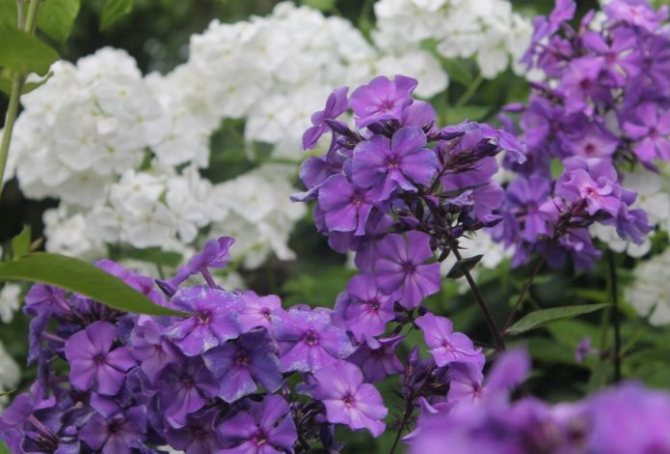

Blooming phloxes delight with a variety of colors
Phloxes love light peat soils and need mineral feeding. Every five years, the plants must be transplanted to other places in the flower garden. Phlox care consists in frequent watering and pruning of faded peduncles to enhance flowering. In the fall, perennial bushes are completely cut off to 2-3 live buds, so that in spring their growth will reactivate.
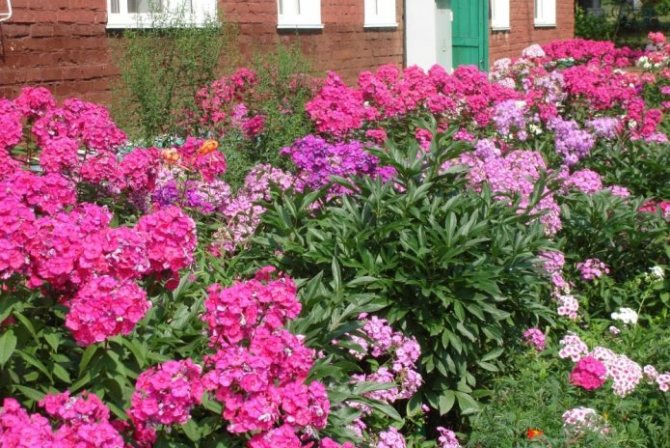

Multi-colored phloxes - decoration of any flower garden
Phlox can be propagated by dividing an adult plant, do it in spring or autumn. The distance between plants is required at least 40-60 cm. At the end of summer, phlox seeds form. You can grow a new plant by germinating seeds in a greenhouse or, with the arrival of heat, they are planted immediately in open ground.
Sedum prominent
Perennial flowering plant with erect stems, resistant to prolonged periods of drought. In the flower garden, it is appreciated for the beauty of dense umbellate inflorescences and fleshy green leaves with wavy edges. It can grow in full sun and partial shade, blooms closer to autumn.


Sedum is valued for the beauty of inflorescences and leaves.
The root system is tuberous and developed, the perennial tends to grow rapidly, therefore, these plants are not planted close to each other. Stonecrop propagates in the spring by dividing the bush or seeds. Young plants require the daily watering they need to root. Adult plants do not need frequent watering.
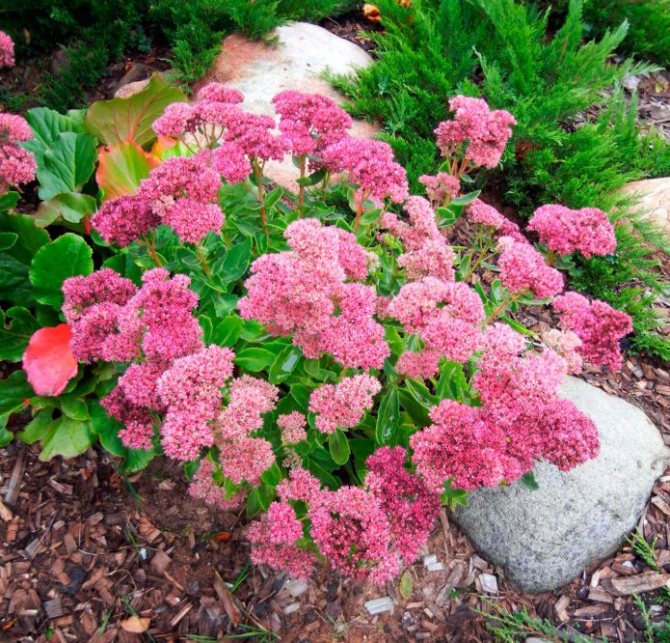

The sedum blooms profusely and does not need special care
Plant care consists of weeding and mulching the soil. Fertilizers are added to the soil to stimulate abundant and long-term flowering. In autumn, stonecrop needs to be cut off - the plant tolerates wintering under the snow well and quickly releases numerous fresh shoots in spring.
Pion-shaped aster
A perennial bushy herb with flowers similar to peonies. The petals of the flower are of various lengths and concave structures, so it looks spherical. The peony aster bush has multiple shoots with peduncles, a perennial grows no higher than 50–70 cm. Flowering begins in July and lasts until October.
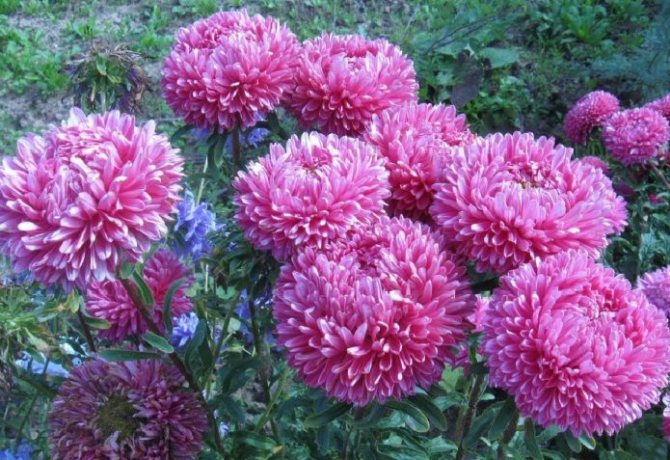

Blooming peony aster
Peony aster does not like highly moistened soil and does not need daily watering. For abundant flowering, plants are periodically fed with fertilizers, but the excess of nitrogenous components is excluded, otherwise foliage will develop instead of buds.
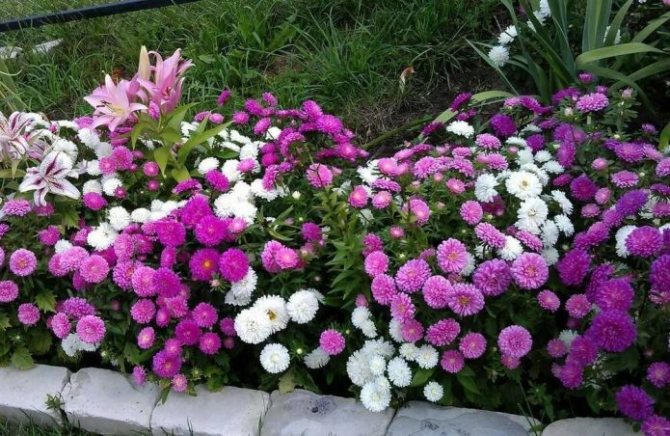

Peony aster in a flower bed
Asters are grown by seedling method or by direct sowing of seeds into the ground. Stratification is used to germinate seeds. In order for peony asters to bloom in July, seeds are sown in April and grown in a greenhouse, and with the establishment of a stable above-zero temperature, they are transferred to open ground.A layer of drainage is laid in the planting hole, and the soil is mixed with fertilizers. Caring for asters consists in weeding, loosening and watering.
Stock-rose (mallow)
A perennial plant with an erect stem and multiple flowers of white, pink, red, burgundy or yellow. The flowers are large, 12-15 cm in diameter, similar in structure to bells. Young plants bloom in the second year of life. For abundant flowering, lasting throughout the summer, the plant needs good lighting. The stock rose is undemanding to the composition of the soil. Its roots extract moisture from deep soil layers.
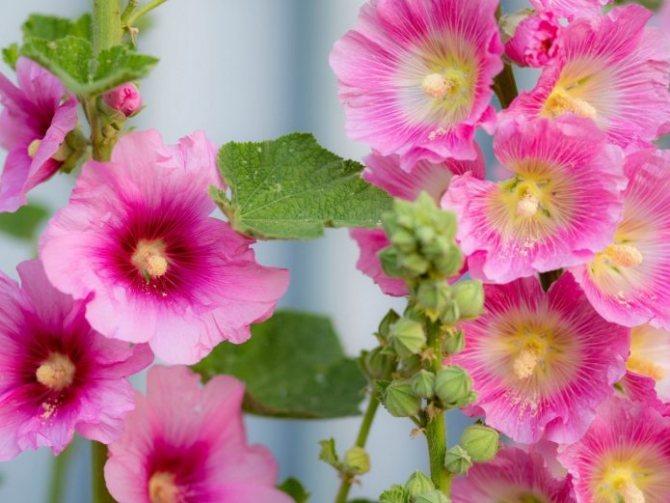

Pink stockrose is a flowering, unpretentious perennial
In a flower garden, the plant can multiply by self-seeding, forming in seed pods near the sepals. Seedlings for planting in the ground are easy to grow on their own; for this, seeds are sown in a greenhouse in March and germinated in order to transfer the seedlings to open ground in early June. Stockrose roots do not like transplanting, therefore, seeds must be germinated in peat tablets.
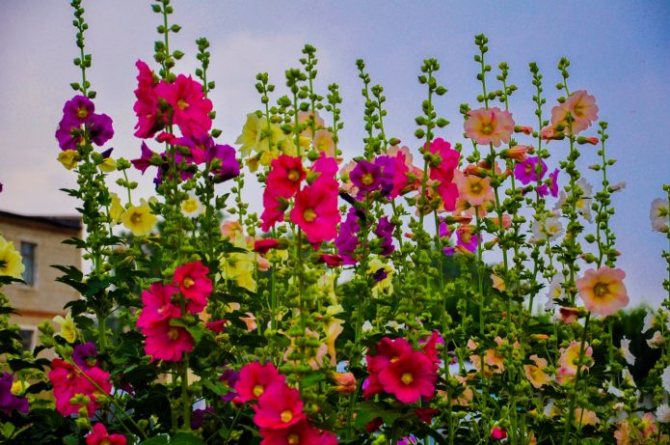

Multi-colored stockroses in a flower garden
In a flower bed, stockroses can occupy a central place in a flower arrangement because of their high, almost one meter tall growth. The plant can also be used to decorate the background, planting more miniature flowers at its foot in several tiers.
Tomato varieties
Tomato varieties are characterized by various criteria:
- By the type of growth of the bush - deterministic and indeterminate
- Ripening time - early, mid-season, late
- By the way of consumption - canteens, for conservation, for the production of juice, etc.
The most common varieties non-standard
tomato, which has thin stems lodging under the weight of the fruit, and large, slightly corrugated leaves; bushes can be both dwarf and tall. Varieties
standard
tomatoes are plentiful. Plants have thick stems, leaves of medium size, with short petioles and close lobes, strongly corrugated; few stepsons are formed. The bushes are compact - from dwarf to medium-sized. Semi-stem tomato varieties have been developed, which occupy an intermediate position between the indicated groups. Varieties
potato
the type, named for the resemblance of its leaves to potato leaves, is very small.
By the type of growth of the bush, tomato varieties are divided into determinate (low-growing) and indeterminate (tall). Have deterministic
varieties, the main stem and lateral shoots stop growing after the formation of 2-6, sometimes more brushes on the stem. The stem and all shoots end with a flower race. Stepsons are formed only in the lower part of the stem. Small to medium-sized bush (60-180 cm). In addition to the typically deterministic varieties, supar-deterministic varieties are also distinguished, in which the plants stop growing after the formation of 2-3 brushes on the main stem (all shoots end in inflorescences and form a strongly branched small bush; the second growth wave is noted after the ripening of most of the fruits; the first inflorescence is formed at a height of 7- 8th leaf), as well as semi-determinate, the plants of which are distinguished by stronger, almost unlimited growth - they form 8-10 brushes on one stem. Have
indeterminate
varieties of tomatoes, plant growth is unlimited. The main stem ends with a flower raceme (the first brush is formed above 9-12 leaves), and the stepson growing from the axil of the leaf closest to the apical brush continues the growth of the main stem. After the formation of several leaves, the stepson ends his growth with the inception of a flower bud, and the growth of the plant continues at the expense of the nearest stepson. This happens until the end of the growing season, which usually ends with the first autumn frost. The bush is tall (2 m or more), but the rate of flowering and fruit formation is lower than that of tomatoes of determinate varieties, extended.
Photo: ideas for flower beds near the house
How the adjoining territory looks like depends on the residents of the apartment building themselves.To decorate the yard with flowers does not require a lot of money and time. The main thing is to make sure that the flower bed does not interfere with anyone, is always well-groomed and the plants in it are beautifully combined with each other. Often, tenants who have summer cottages share planting material free of charge and take care of green spaces with pleasure. Such flower beds become not only a symbol of comfort, but also contribute to good-neighborly relations.
To create an adjoining flower garden, you have a huge scope for creativity in the selection of options for flowering and decorative leafy plants, and a sense of proportion and floriculture skills will become the key to success. Let your miniature garden be the most beautiful and unique, to the delight of people!


Flower beds do not become outdated and, as before, they can be seen in city parks and squares, in summer cottages and in the courtyards of private houses. Traditionally, they are created round and rectangular, but they can also be more daring configuration: in the shape of a star, a semicircle, a butterfly, a flower.
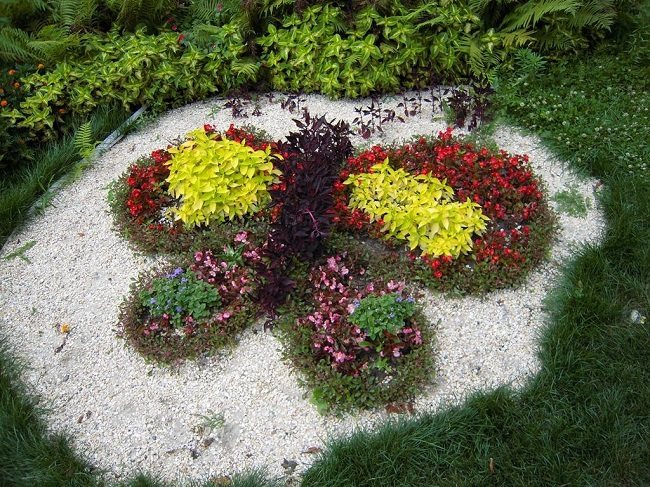

Flower beds, decorated in a natural style, are very fashionable, in which, along with garden plants, ornamental grasses and cereals are used.
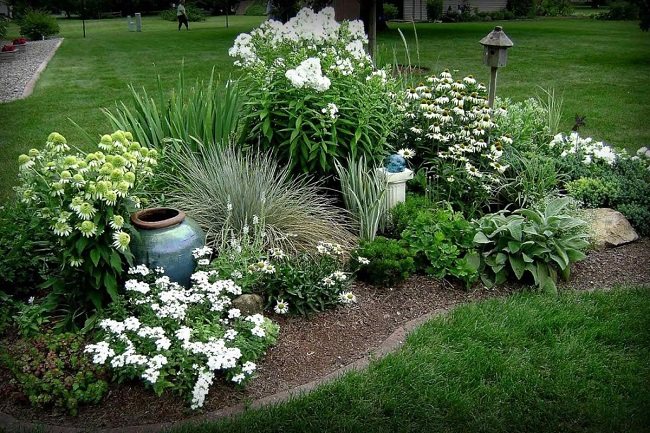

But for the flower garden to turn out beautiful, it is not enough to buy a few bags of seeds and sow flowers in an empty area.
Scientific classification of fruits
The fruit is called the final stage of flower development. It is formed under the influence of double fertilization. It is a generative organ that serves for the formation, development and distribution of seeds.
In different countries and at different times, the fruits of the tomato were referred to as vegetables, fruits or berries.
The main differences between these fruits.
- The berry is a multi-seeded fruit, the pulp is juicy, covered with a thin leathery epicarp (outer cover).
- Fruit is the juicy edible fruit of a bush or tree. This is not a scientific, but an everyday name. Usually refers to large fruits.
- Vegetable is a rather vague culinary and agricultural term. According to the definition of the professor of the TSKhA V. I. Edelstein - these are "herbaceous plants cultivated for the sake of their juicy parts, used for human consumption." This group includes plants from which roots, leaves, stems or fruits are eaten.
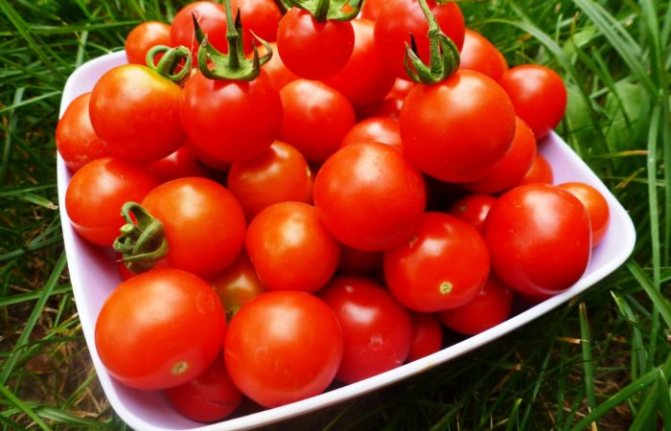

A flower bed and a flower garden, what is the difference
There is some difference between a flower bed and a flower garden. A flower garden can be called any piece of land on which ornamental vegetation is planted in any order. They may include many annuals, deciduous shrubs and conifers.
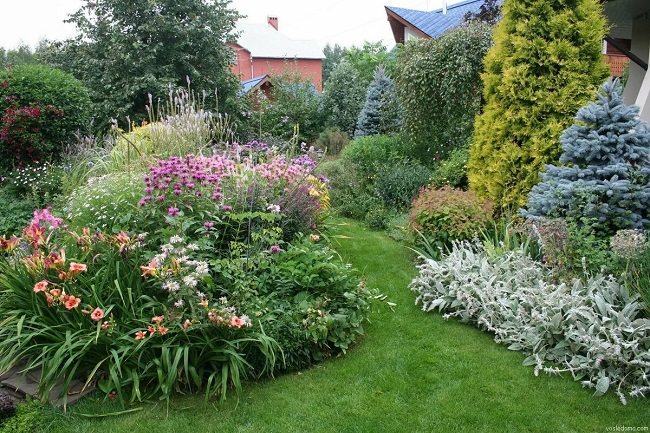

A flowerbed is called a flower garden of the correct geometric shape, in the design of which mainly annual crops and herbaceous perennials are used. Plants in a flower bed are planted in a certain sequence, observing symmetry.
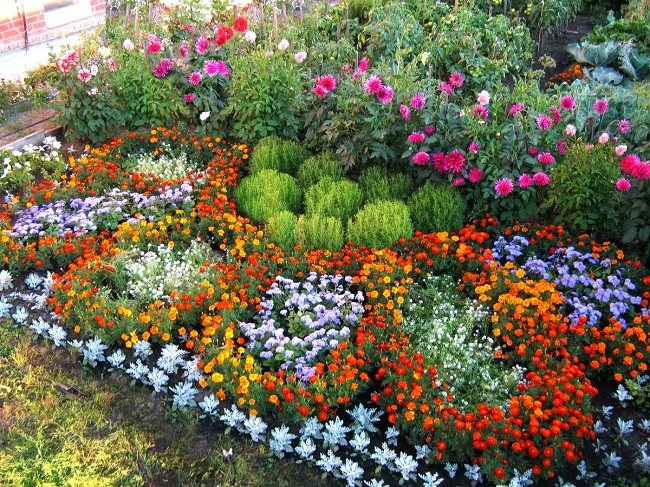

Usually the flowerbed has a closed circuit. It is surrounded by garden paths, paving or embedded in a green lawn. A narrow floral border is created along the perimeter of low-growing annuals or ground cover species of perennials.
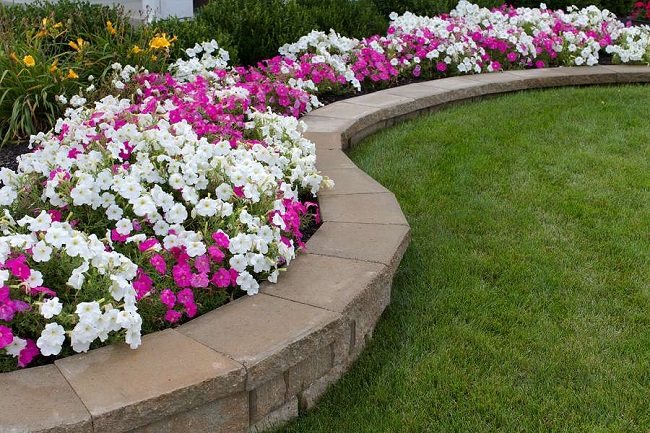

As an exception, sometimes flower beds are arranged, one side of which is bordered by a fence or wall of the house. But in this case, it should not be confused with a mixborder, the principle of which is somewhat different.
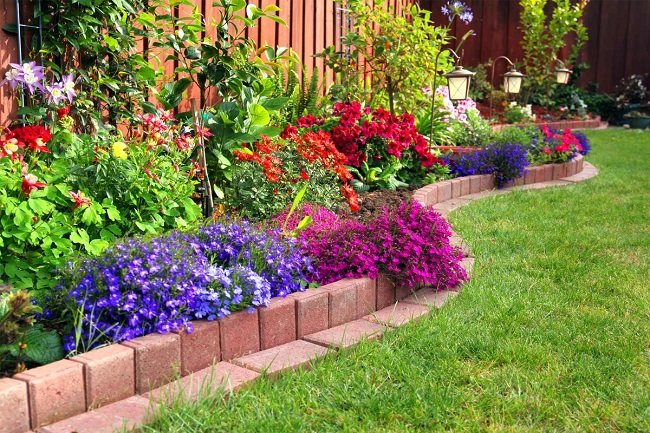

Interesting. A flower bed can be called a type of flower garden. But a flower garden is not always a flower bed. This is a broader concept that includes alpine slides, rockeries, mixborders and other floral arrangements.
Classification
Currently, there are several classifications of tomatoes. In Russia adopted [3] the traditional classification of Brezhnev. In the traditional classification [4], tomatoes are considered to be members of the genus Lycopersicon Tourn. In 1964, the Soviet plant breeder D.D.Brezhnev in the genus Lycopersicon
three types were identified [5]:
- Peruvian tomato Lycopersicon peruvianum Brezh.
- hairy tomato Lycopersicon hirsutum Humb. et Benp.
- common tomato Lycopersicon esculentum Mill.
The most complete classification of the genus Lycopersicon
is [3] the classification of the American professor C. Rick (C.M. Rick; 1915-2002), who described 9 types of tomatoes:
- Lycopersicon cheesmanii
, - Lycopersicon chilense
, - Lycopersicon chmielewskii
, - Lycopersicon esculentum
, - Lycopersicon hirsutum
, - Lycopersicon parviflorum
, - Lycopersicon pennellii
, - Lycopersicon peruvianum
, - Lycopersicon pimpinellifolium
.
Modern phylogenetic botanists consider the genus Lycopersicon
paraphyletic, on the basis of which tomatoes are attributed to the genus Nightshade (
Solanum
). In connection with this approach, the same plants have synonymous names:
| Russian name | Traditional classification | APG II classification |
| Common tomato | Lycopersicon esculentum | Solanum lycopersicum |
| Peruvian tomato | Lycopersicon peruvianum | Solanum peruvianum |
| Currant tomato | Lycopersicon esculentum ssp. pimpinellifolium | Solanum pimpinellifolium |
In practice, gardeners continue to use traditional names, while strictly botanical literature uses the second option.
Types of flower beds: regular
According to the method of planting plants, flower beds are regular and irregular. More laborious in the device are regular ones: plants of about the same height are selected for them, necessarily undersized annuals and ground cover perennials. It is important to select all species in such a way that their flowering coincides. The main feature of regular flower beds is the clarity of the lines that form a beautiful geometric ornament.
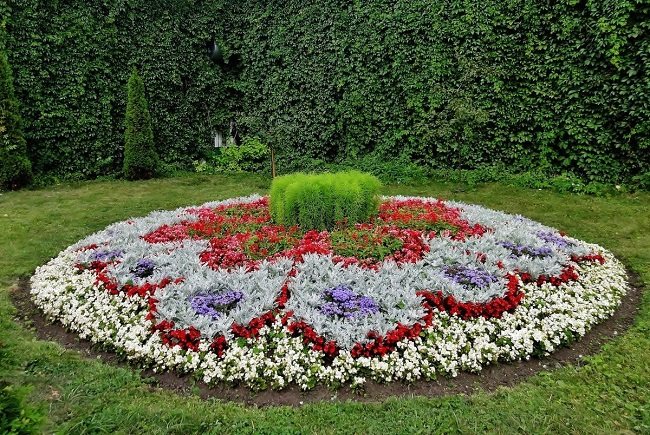

Regular flower beds are rarely created on the backyard territory; their prerogative is city parks and squares. This type of flower beds requires constant care, the complexity of which lies in the fact that the root system of perennials grows rapidly, knocking down the pattern. But, if you have the time and desire to create something special near a private house, you can try.


First, an ornament of the future flower bed is drawn up on a sheet of paper, on which different types of plants are indicated by color. Then the drawing is transferred to the area with prepared soil: the lines of the pattern are drawn with the help of sand. And only after that, plants are planted in a strictly defined order (in accordance with the plan).


Advice. If on the site it is decided to make a flower bed of a regular type, you can use vegetation with foliage of different colors in its design: spotted clover, creeping clover, trapezoidal oxalis, blood-red geychera, various varieties of tenacious and saxifrage.
The main parts of the tomato plant
Like all representatives of the flora, the tomato plant consists of several parts, the main ones being: roots, stem, leaves, inflorescences and fruits.
The root system of the tomato is pivotal, with good branching and the ability to penetrate to a depth of 1-1.5 m.
Stem length from 30 in dwarf to 300 cm and more in vigorous varieties.
As you can see in the photo, the branching of the tomato plant is sympodial, that is, the growth of the shoot ends with an inflorescence, and the continuation shoot is laid in the axil of the first leaf below the inflorescence:
The first-order shoot is called the main stem. In the axils of the leaves, branches of the first order are formed, which are called stepchildren.
Inflorescence is a curl, called a brush, in which there are from 7 to 20 flowers. By its structure, the inflorescence of a tomato plant can be simple and branched.
The fruit of a tomato is a juicy two- and multi-nested berry weighing up to 600 g or more. Strongly different in form: from traditionally round and flat-round to ovoid, pear-shaped, pepper-shaped, banana-shaped, etc.
Tomato pulp of different colors and shades: red, pink, yellow, orange, green, brown.
The following are photos and characteristics of the structure of the tomato bush.
Types of flower beds: irregular
In the country, it is easiest to make an irregular flower bed, which is more free execution. Flowers in it are arranged in rows or pointwise, several plants in a group. So that bald spots do not form in the flower garden, ornamental grasses and cereals are sown between large species.
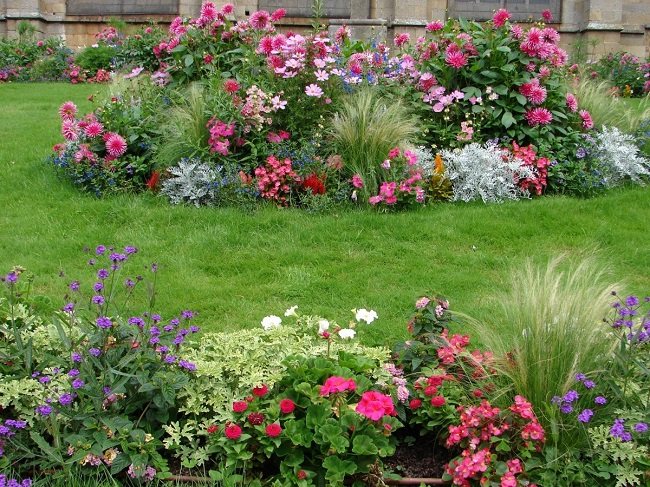

Markup
It is much easier to make a flower bed if you initially mark it out. Regardless of the size of the future flower garden, the breakdown will greatly facilitate further efforts to create it. For marking, you will need sand, pegs and strong twine.The easiest way is to outline the boundaries of a square or rectangular flower bed. Low pegs are driven in at the corner points and connected with a rope.
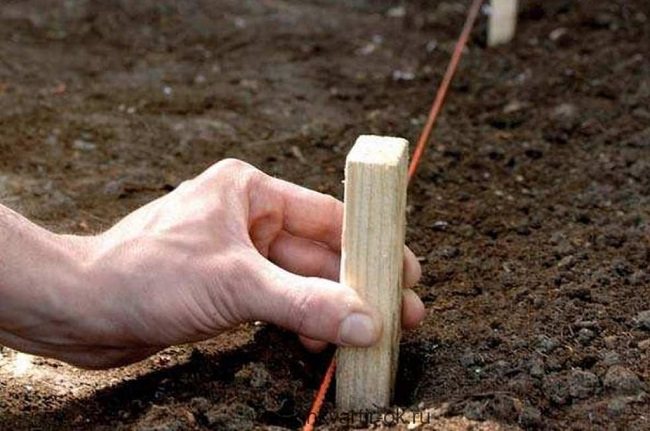

Then, along straight lines, a groove is dug under the string, and a concrete curb is installed in it.
It is not much more difficult to break a round flower bed. You need to measure the diameter of the circle and divide the figure in half (find the radius). Then a peg is driven in the center of the flower garden, a rope is tied to it (its length is equal to the radius of the circle) with a piece of reinforcement tied to the opposite end of the twine. Having pulled the rope, it is rotated around a fixed peg, while simultaneously drawing a line with the end of the reinforcement until the circle closes. So that the line does not get worn out, it is designated with a strip of sand, after which a border is dug in.
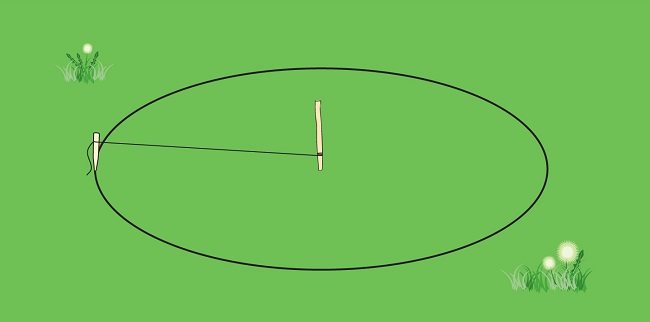

Advice. The curb can be made from scrap materials, such as old brick. It fits according to the domino principle, that is, one-on-one obliquely.
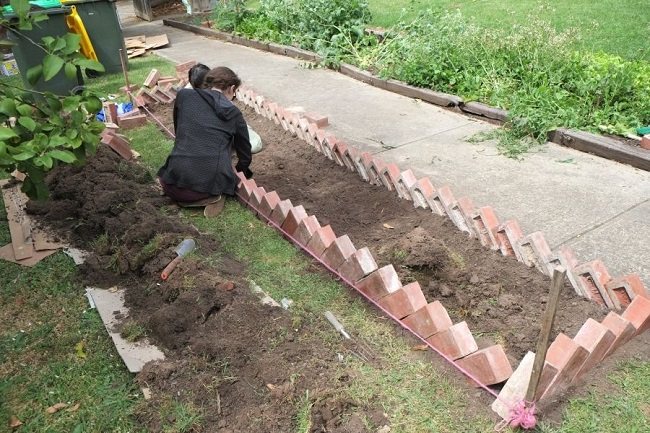

Soil preparation
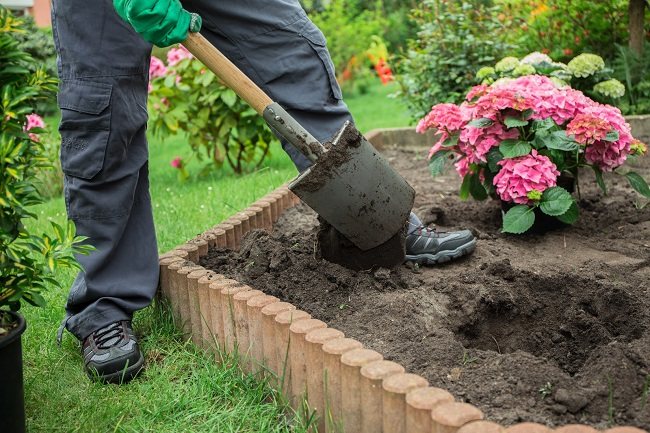

Since the fall, the preparation of the site for the spring planting of seedlings begins. First, the type of soil is determined and, if necessary, it is improved. For each type of soil, different additives are used, which are evenly distributed over the surface of the future flower garden, and then deep digging is carried out.
How to make your soil better:
- Clay soil. The heaviest type of soil, and it is most difficult to increase its fertility. Ideally, you need to remove the top layer of 30 cm, and replace it with black soil. Since not everyone can do this laborious work, you can do it differently: bring in sand, peat and humus and mix it with the ground on the site by digging;
- Sandy soil mixed with imported chernozem;
- Loam are improved by the introduction of humus and sand.
It is recommended to dig up the plot in the fall, when the first rains have passed and the earth will soften under the influence of moisture. But you should not do this immediately after rains, so that the soil does not stick to the shovel and shoes. During digging, the remaining weed roots and stones are removed from the soil.
Important. Immediately after digging, the earth is in a loose state, and then, under the influence of rains, it compresses and settles. Therefore, initially the site should be about 15 cm higher than the lawn. In this case, after shrinkage, the flower garden will not be below the soil level.
Selection and planting of plants
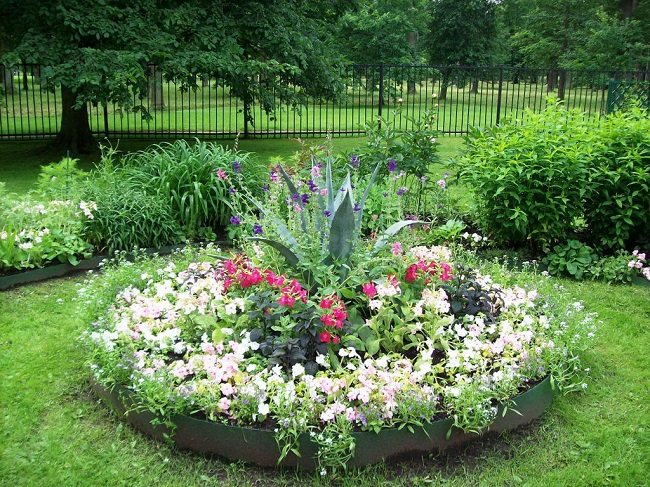

A classic round flower bed is made up of several plant species, differing in color and habit. The tallest flowers are planted in the central part, and their height gradually decreases as they approach the edge. The flowering periods are also taken into account. The bulk is made up of annuals that bloom all summer, and between them are perennial plants, which for the most part do not differ in the duration of flowering.
Tips for decorating a flower bed
It is true that experience comes with time. But I really don't want to learn from my mistakes. To make the design of the first flower bed in life smoother, it is better to listen to the advice of experienced florists.
Tips for beginners:
- It is better to make several small flower beds than one large one, since a small flower garden is easier to care for;
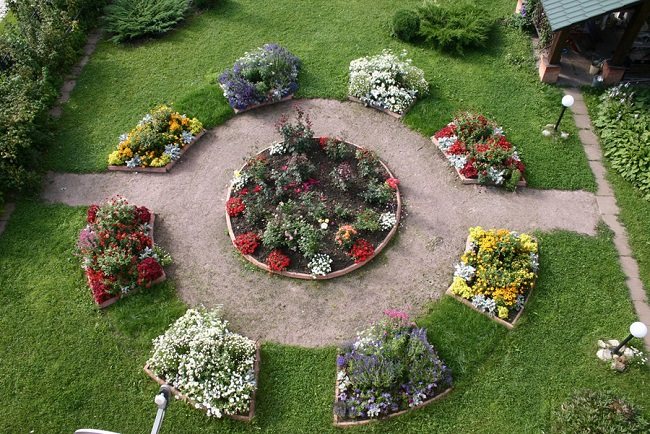

- In a flower garden that is too long, it is difficult to grasp the distant details;
- The diameter of a medium-sized round flower bed is about 2 m;
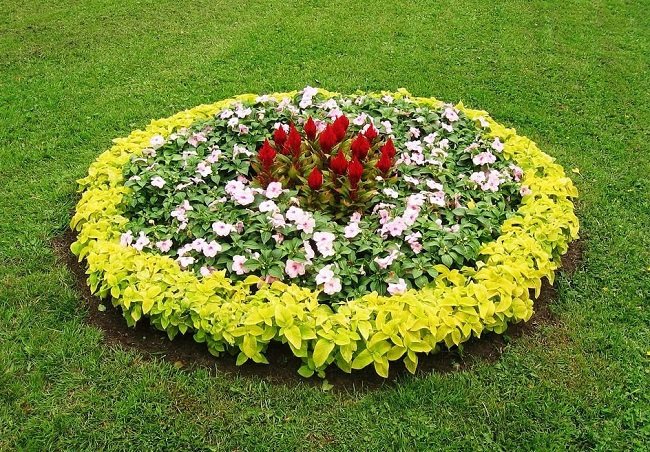

- A round flower garden looks more impressive when its central part is slightly raised;


- If the flowerbed is made on a lawn, it should not be limited by concrete or any other curb. It is better to make a border from low annuals - this way it will look more natural.
- So that the lawn grass does not capture the territory of the flower garden, a plastic border tape is dug in along its perimeter;


- You should not save by planting plants too densely, as they will stretch and bloom poorly;
- In too thick plantings, diseases develop faster.
A few words should be said about rhizome plants.Their root system is growing rapidly, so every 3-4 years, the flower garden is renewed or reconstructed. In autumn or early spring, overgrown species are dug up, the roots are divided into sections, and the renewed planting material is planted back in place. So that the process is not too tedious and does not take several days, you can separate the most grown species every year. It should be noted that some perennials, such as irises, divide from June (when the flowering period ends) until the end of summer.
Useful video on forming a simple flower bed:
What is a tomato from different points of view
"What group should a tomato belong to?" - this question has been pondered over for centuries in different countries. The main definitions of this culture:
Common tomato is a vegetable crop that grows on all continents. It is widely cultivated on the territory of Russia (in the Far North in hotbeds and greenhouses). Productivity in greenhouses is 5-15 kg 1 m 2, in open beds 150-250 centners per hectare.
- From a biological point of view, tomato (Latin Solanum lycopersicum).
It is a herb (annual or perennial) belonging to the Solanaceae family. Stem length is from 30 cm to 5 m. Core root system, leaves are dissected. Inflorescences are flower or fruit clusters (simple, intermediate or complex). The flowers are bisexual, self-pollinating.
The fruit is a juicy two-celled or multi-celled berry with a smooth or ribbed surface of various shapes.
- From the point of view of the layman.
This vegetable, since it grows in the garden, is used for preparing first, second courses and salads. The fruit is not sweet, therefore it is not a dessert.
Unusual flower beds
There are always exceptions to the rules, they also exist in the art of decorating flower beds. Bright, non-standard flower beds bring a special chic to the design of the suburban area. Unusual flower beds are not lost in the landscape and always attract attention with their originality.
Floating flower beds


The flower islands floating on the mirror of the reservoir look original. Fertile soil is poured onto a sheet of polystyrene with low sides, and seedlings of low annuals are planted in it: petunia, purslane. The islet is tied to an anchor (large stone) so that it is not carried to the shore. You can decorate with a floating island not only an artificial pond. If the dacha is located on the shore of a natural reservoir, islands are arranged along the coastline of the site.
Advice. A floating flower garden does not need to be watered if small through holes are made in the foam, through which moisture will flow to the roots directly from the reservoir.
Vertical flower beds
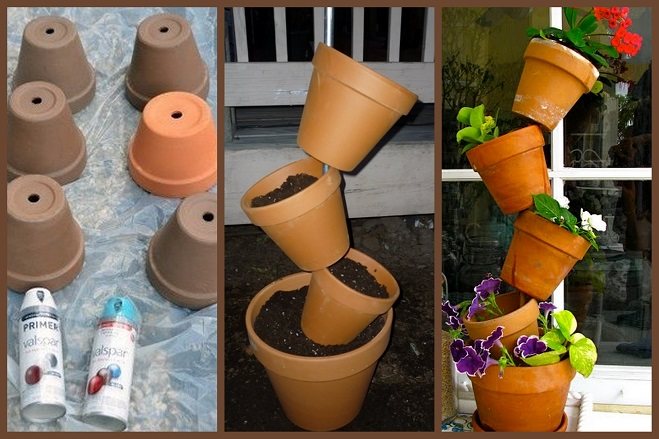

Vases with flowers are arranged in staggered order on a metal frame specially welded for this purpose. The advantage of a vertical flower bed is that it is easy to maintain as it does not require weed control. In its design, garden and indoor plants are used, as well as decorative garden figurines. A vertical flower bed is installed anywhere: on the lawn, near the porch, on the paving in the yard.
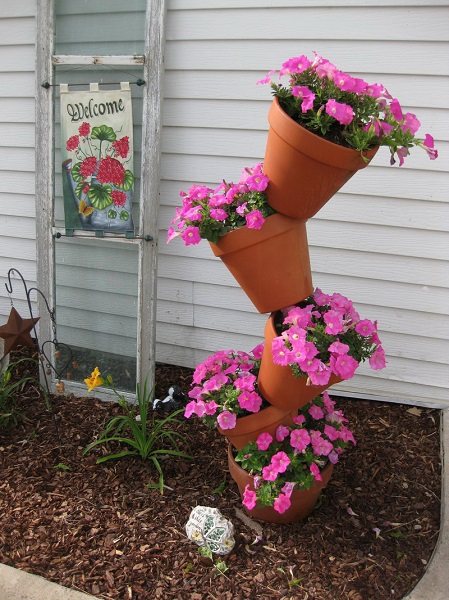

Advice. Attention should be paid to the fact that potted plants need more frequent watering.
Monoclumba
Monoclumba, which are made up of plants of the same type and color, look beautiful on a green lawn.


The downside is the short flowering time. You can compensate for the deficiency by planting several types of plants in turn with different flowering periods. For example, first low-growing white tulips, then blue lobelia or blue ageratum, and at the end of summer - ruby asters. Thanks to this technique, the country landscape will be updated throughout the season.
Raised flower beds
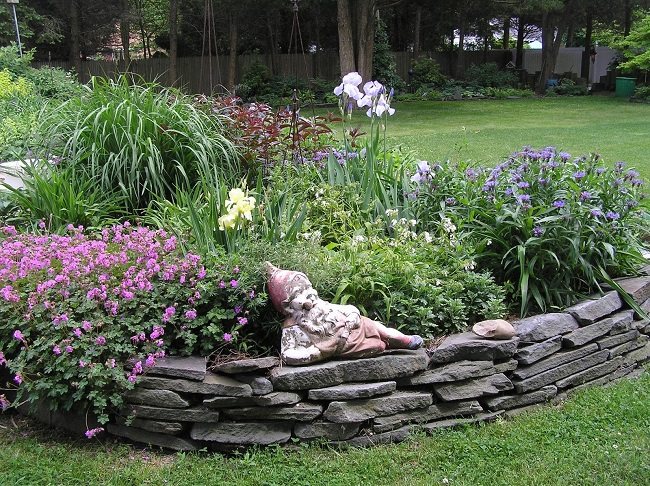

The elevation of the flower garden is achieved by a parapet lined with bricks, wild stone or concrete blocks.The interior space is filled with soil in such a way that it does not overflow the edge. Plants are planted according to the same principles as in a regular irregular flower bed.


On a note. Instead of a parapet, you can make a high curb from any lumber: planed boards, slabs, beams.
Useful properties of tomatoes
The beneficial properties of tomatoes are not only in a set of vitamins and mineral salts, among which a special place is occupied by iron, which is contained in it in greater quantities than in chicken meat, fish, milk. In terms of the amount of vitamin C and carotenoids, tomatoes are not inferior to citrus fruits.
Recently, lycopene (lycopene), which is abundant in tomato, watermelon, and apricot, has attracted special attention among carotenoids. It ranks high on the antioxidant scale and as a protector of the cardiovascular system. Its high level in the blood prevents the development of the early stages of atherosclerosis, since it does not allow the inner layer of the vascular wall to thicken. It is useful to know that the bioavailability of lycopene is increased by 3 times in tomatoes that have undergone heat treatment with the addition of vegetable oil.
Recently, the anti-cancer effect of tomato has been discovered, in particular against breast and prostate cancer. The presence of folic acid promotes hematopoiesis and normalizes cholesterol metabolism. Tomatoes are valuable for increasing the alkaline reserve of blood. They are recommended for consumption by people with disorders of the cardiovascular system, metabolic processes, and stomach diseases. You must be careful with green tomatoes, tops containing the glycoalkaloid tomato, which is toxic to the body in high concentrations (when canning green tomatoes, it is destroyed).
Mini-flower beds - fantasy is not forbidden
The concept of a flower bed has expanded, and now it is proposed to make it out of any object, the main thing is that it can be filled with soil. Such creative mini-beds look pretty cute and delight with their uniqueness.
The most common option is small hanging flower beds. Earth is poured into a linen bag, leather boot, rubber boot or old mailbox and a plant is planted here, preferably ampelous. An improvised flower bed is hung on a fence or wall of a house as a decor.


Non-standard flower beds are obtained using pieces of furniture. Any unnecessary thing prepared for a landfill (bed, chair, table, sofa) is put on the lawn, partially covered with soil and planted with flowers. They also do the same with leaky boats, wooden crates, garden wheelbarrows, wicker baskets, and even cars.
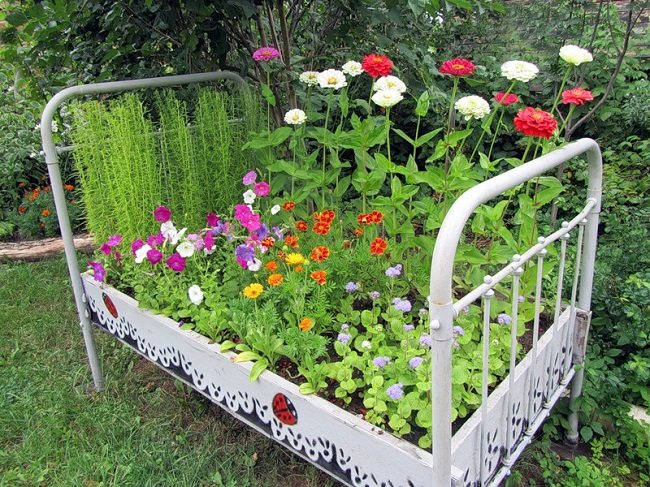

It is now fashionable to use old objects in creating flower beds. But there is one drawback - under the influence of moisture, fabric and wood are destroyed. To extend the life of a flower bed for several years, wooden parts are varnished or painted, and plastic bags are put into leather and fabric items, and only after that earth is poured inside.

